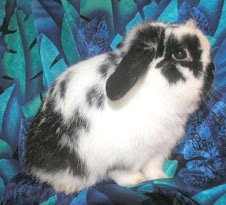We are awash with babies right now. The scourge of a breeder is what to do with the extra babies. To make progress in our herd, we have to keep breeding. Our goal is to produce babies better than their parents.
We linebreed, which means we often get some very nice babies in a litter and some that need to be culled out of the breeding program now.
We do our first sort at about five weeks. We cull babies who are much bigger than their litter mates, those with obvious disqualifications, and those who already lack the head/ear shape or body that we want. They don't grow out of things like low headset or low shoulders. We also examine their feet. We want a short, wide foot and often compare a litter's feet.
We once kept a doe only based on her feet. She had lovely wide feet although her body seemed long and narrow. But at about 4 1/2 months, her body went schloomp! And we had a wide, short doe who granded early and has stayed home to produce several show-quality babies.
Another sort happens around 8-9 weeks of age. We continue to look for nice smooth hindquarters, good width at the shoulder, nicely balanced crown.
Then we ignore them. Well, not literally. We handle them a lot, putting them on a carpeted table and try to simulate how a judge would work with them. But we try not to look at head or body at this point.
They go through the familiar uglies until they're about 4-4 1/2 months old. That's when we do the next sort session. It's amazing how they change over the six weeks. (OK, it's hard not to notice bodies and heads when we're handling them in this time frame. But we try not to select who to keep.)
With our bucks, we find that another sort happens at 9-12 months, when we see if the promise of the baby has reappeared yet.
We believe that a sound culling program will strengthen our herd and we're trying to learn and grow in that area. So we're growing out several juniors now, knowing they have at least two more cuts to pass before we incorporate them into our breeding program.
Monday, September 21, 2009
Wednesday, September 9, 2009
State fair
Timothy had a good run at our State fair this year, picking up a BOB with his solid junior buck, Geo. What he thinks is cool is that this is not the solid junior buck he won BIS with a few weeks ago.
The two bucks are similar in age, color and size, but different in type. So Timothy now goes to shows with something that might appeal to different judges' eye.
Some judges are what we call "head" judges: they look for a nice head/ears/crown combo and pay much less attention to the body. Others seem to prefer smooth, balanced bodies and will forgive weaknesses in the ears and/or crown.
What we think are the best judges, of course, are those who look at the entire Holland and find the one who scores the most points according to the ARBA standards.
But it doesn't hurt to go to shows with more than one style of animal, just in case the one who's done well in the past doesn't excel in what a particular judge is looking forward. When we can, we try that approach to our selection of who to take to the show.
The two bucks are similar in age, color and size, but different in type. So Timothy now goes to shows with something that might appeal to different judges' eye.
Some judges are what we call "head" judges: they look for a nice head/ears/crown combo and pay much less attention to the body. Others seem to prefer smooth, balanced bodies and will forgive weaknesses in the ears and/or crown.
What we think are the best judges, of course, are those who look at the entire Holland and find the one who scores the most points according to the ARBA standards.
But it doesn't hurt to go to shows with more than one style of animal, just in case the one who's done well in the past doesn't excel in what a particular judge is looking forward. When we can, we try that approach to our selection of who to take to the show.
Subscribe to:
Posts (Atom)







